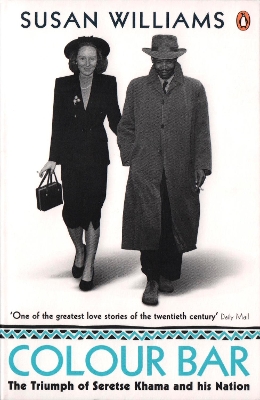Reviewed by Heather on
I had never heard of Seretse and Ruth Khama until I saw an advertisement for the movie adaptation of Colour Bar. It was only playing for one night here and I wasn't able to go. The story sounded interesting so as soon as I realized that it was based on a book, I got it from interlibrary loan.
Seretse Khama became the kgosi (chief) of his tribe at the age of four. His uncle was installed as his regent. They lived in Bechuanaland which is present day Botswana. At the time this was under the control of England. His uncle made sure that he was well educated by sending him to schools in South Africa and then sending him for a law degree in England. There he fell in love with Ruth Williams, a white woman.
When he announced their intention to marry in 1949, opposition came from all sides. They married anyway. Eventually, he was able to convince his tribe that this marriage was acceptable. He was not able to convince white people though.
The main objection came from South Africa. They were in the process of codifying apartheid law. They did not want the leader of a country on their border to be in an interracial marriage. Since this was an hereditary position, the next leader would be mixed race. If Bechuanaland was successful, it would make of mockery of the South African laws. South Africa was an important part of the British Empire. They fought to make sure that Seretse Khama was unable to lead his people.
What followed was years of exile from Africa and abuse at the hands of British officials. This book is exhaustively researched. It quotes from many, many letters and official documents to let the English racism speak for itself. It is brutal. There is also a lot of discussion about what type of woman Ruth must be to be willing to marry a black man.
This book was fascinating but it is a slow read. It is very dense with details of meetings. It focuses on the political aspects of the story, not the human ones. You don't get much of a sense of Seretse and Ruth's personalities except for in a few of their reactions to what is being said. It doesn't delve much into what is going on in their minds or the true stresses on their relationship while all this is going on.
I wasn't surprised by the racism that they encountered but there times when I had to take a minute to digest the absolute depth of the hatred and ignorance in the writings and public statements of British officials. They were so willing to appease the hatred of whites living in southern Africa that they would go to ridiculous lengths. There was always a problem of getting the Khamas to and from Bechuanaland from England. They had to land in Rhodesia which was strictly segregated. You'd think they were negotiating a nuclear treaty the way they had to deal to allow planes to land with them onboard or to let Ruth and the children stay in a hotel overnight. (They basically had to promise that the children would not be seen so they didn't offend delicate white sensibilities.)This review was originally posted on Based On A True Story
Reading updates
- Started reading
- 1 May, 2017: Finished reading
- 1 May, 2017: Reviewed
